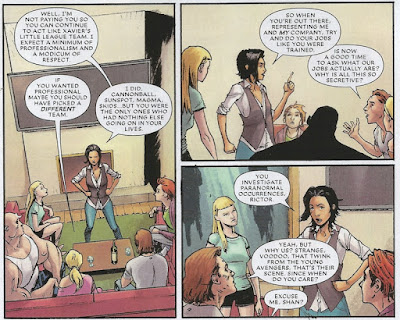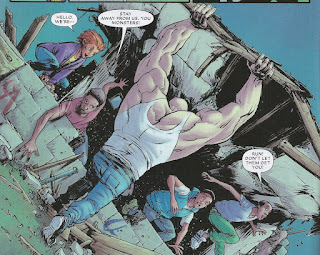Pick of the Brown Bag
March 21, 2018
by
Ray Tate
Hello! Welcome to the Pick of the Brown Bag. For this post I’ll review The Amazing Spider-Man, Aquaman, Batman, The Mighty Thor, Monsters Unleashed and Southern Cross. No time for the full length critiques? Check me out on Twitter: #PickoftheBrownBag.
Remember this guy?
“I also know they probably do not have the logistical ability to plan a nationwide rally —"
Yeah…Over 200,000 people mostly kids in Washington, D.C. protesting the government's lockstep with the NRA. That’s not factoring in the multitudes taking a stand in U.S. Cities and around the world supporting March For Our Lives. Ignore the cretins. You go, kids. You go.
Important reminder for the casual Supernatural viewer. March 29, 2018 it’s Scooby, Scooby-Doo!
Decades ago, Chuck Dixon unwittingly catalyzed a little stir. The controversy referred to Batman and the Outsiders. Batman parlayed with Thunder, Black Lightning’s daughter.
The dialogue made mention of Thunder’s “special relationship” with another female hero. I forget her name. I had already begun my partial or total boycott of DC over Barbara Gordon’s everlasting crippling. So I never actually read the issue, but I got wind of the big deal and remember the Scans Daily viral image. I’d post it, but I’m not trying to cause trouble or open up old wounds. Have a tiger cub instead.
Some people took Batman’s comments as a slight against the LGBT community. I just felt they were out of character. Not Dixon at his best. I remember thinking that the word special didn’t need to be there. Dixon however wrote oodles of Batman comics. Most of them good, that includes Robin. The only time you knew he was a conservative occurred when he orchestrated a dumb way to get Batman to fire a gun, something he would never do. Oh, and please, Batman scholars pulling out 1930s images of Batman with a gun. I’m well aware of the blips on the radar, as well as the Batmobile and Batwing’s armament in Michael Keaton’s films. Just don’t. My point is the kerfuffle in my opinion was more of a ker-chew, but hey, nobody had healed Barbara. So I didn’t really care that much anyway.
Batman’s not a conservative, nor is he a progressive liberal. His politics are beyond pigeon-holing. He loathes guns because a gun cost him his parents’ lives. He’s the ultimate detective and stands within the top ten tier of DCU scientists. He respects the law, but sees it as too unbalanced favoring criminals. He attacks crime on two fronts. As Bruce Wayne he instigates philanthropic social change to destroy poverty. As Batman he addresses evil with his fists and stylized weaponry such as the Batarang. At the same time, he would like nothing better if his rogue’s gallery reformed. He believes change is possible. That’s what this issue of Batman is about.
Batman does not care and never cared about sexual orientation. Why would he? The ratiocinator and scientist can only see LGBT as a genetic variation ingrained in DNA soul. Heterosexuals commit the most crime, but even so. The criminal element is a minority sample of all the people he swears to protect. Furthermore, he even spreads his wings for a share of that population.
What’s interesting about the scene is that Batman has grown through his relationship with Catwoman to understand love. From a social perspective, from the perspective of the ker-chew, It’s important that Batman recognize Harley’s and Ivy’s love as equivalent to his and Catwoman’s love, but it’s far more important for the history of the character, that Batman comprehends love as an unstoppable force of nature.
Ivy speaking through Harley is stunned that Batman is that evolved. Ivy primarily sees Batman as an enemy.
Although powerful women, Ivy and Harley know that there’s a whole group of ignorant assholes that don’t support their relationship. If they could, they would kill Harley and Ivy because of that relationship. No other reason. Just that relationship. Ivy knows Batman isn’t one of them, but she also suspected he wouldn’t approve. She misjudges Batman and through that slip loses her current scheme in the most optimistic way possible.
As it turns out, this is another chapter of Batman that alludes to past issues of King’s run. Here, King explores Batman as the detective.
Ivy’s intent is based upon her guilt over her actions long ago in “The War of Jokes and Riddles,” Batman reveals the things that only he would discover. Sherlock Holmes and the Shadow acknowledged Batman as their rightful successor, and his dispensing with the misplaced rationale behind Ivy’s current ploy exemplifies why. Batman though is also a force for change. His acknowledgement of Ivy’s potential, echoing her debut in the New 52, demonstrates his want to help people not just strike down the criminal but to genuinely find a means to deliver justice.
Aquaman is like one of those weird Forever Evil snapshots of the villain. In this case, it’s Corum Rath, current usurper ruler of Atlantis. The story begins with Rath and Dad working in the coral mines. Already, down, down.
Later in Rath’s reverie, he portrays his father as a violent, abusive man. Rath however is an unreliable witness, given his penchant for delusion.
Rath never punched his fist through Aquaman’s chest. Aquaman also never appeared bloated like a puffer fish.
Abnett fills in some of the blanks about Rath’s background and his friendship with would-be Aquaman assassin Kadaver.
It’s during this period that Rath develops an unsavory hatred for Atlantean mutants. The issue of Aquaman didn’t grab me, mainly because I think of Rath as a Donald Trump styled putz.
Trump is the nightmare idiot. He's a fool that has access to the most dangerous weapons humankind ever produced. He can and most likely will exterminate all life on this planet. Rath is dangerous because his position allows him access to Atlantean magical artifacts that can rain death on earth. For inexplicable reasons beyond fear Trump amasses loyal followers. Finally, below the depths, the Court of Atlantis begins to roil.
Rath naturally pulls a nasty trick that may stem the tide and his dubious ethics breezes past the collateral damage to so-called friends. Aquaman also marks the return of former Batman artist Kelley Jones to the DCU. Jones has lost none of his finesse, and this nebulous story speaks to his strengths.
Southern Cross returns with psychotronic body horror. For those of you that came late to the party, Alex Braith booked passage on the space cruiser Southern Cross. She embarked to discover the truth about her twin sister’s death. That truth appeared to involve aliens, and the whole banana seemed to be a straightforward science-fiction mystery. That changed as Southern Cross followed up with volume two.
There are two types of aliens. There's the unusual extraterrestrial that never the less utilizes science that we poor humans can still understand. The Daleks for example though startling in appearance use devices like a suction cup and a death ray. The Klingons possess cloaking devices that hide their ships. These things we instinctively know to be engineered and therefore normal.
The second type of alien is the kind that H.P. Lovecraft created as a hobby. The freakish monsters drove normal human beings mad if they were lucky, and their methods made one’s skin crawl. You can describe Cthulhu as a big bloated octopus with bat’s wings, but that’s only what our feeble minds can comprehend. Lovecraft’s Cthulhu is so much more indescribable. We can joke about the creature in the comfort of our reality, but if such a being truly existed and we found ourselves in its presence, I imagine our brains would turn inside out.
Southern Cross seemed to be fostering aliens that though odd could be understood. It turns out that there’s another side that dropped straight into the pit of Lovecraft, and this issue with its apparent drug-catalyzed dialogue and horrific imagery just bursts with gooey metamorphoses that would induce a song in Lovecraft’s heart.
The book opens up Aliens-like with mercenaries locked and loaded and ready to kill the bugs. This isn’t a bug hunt.
The grotesque, rude creations would have made Lovecraft, something of a prude, blush although they are the next generation of his freakish literary children. The mercs provide much of the action. Alex and her crew of miscreants draw more on the psychological and the threat of sexual terror.
Out of context, Alex’s statement can be considered flippant, but that’s not actually the case. Lacing the promise with the previous scenes, it’s actually high drama based upon Alex’s orientation. If you needed even more hints, the creative team of Andy Belanger, Becky Cloonan and Lee Louridge have got you covered.
One of the motif’s in Southern Cross is a cutaway display that dispenses with panels and simply shows a series of figures striding and climbing through the belly of the beast across two pages. In this issue, we see a freak show of anatomical rape that reminds one of Brian Yuzna’s Society. Southern Cross is not for the faint-hearted, but if you have the stomach, the powerful issue is a must read.
Monsters Unleashed on the other hand is positively charming. Hard to believe the monicker used to belong to an adult-themed magazine. After bringing giant bees back to his island home, Kei Kawade also known as Kid Kaiju found himself grounded. His parents however mellowed just a tad and allow Kei to attend a picnic with his friend Lunella alias Moon Girl and her partner Devil Dinosaur.
Lunella is a genius, and she’s whipping up a device that will allow Kid Kaiju to understand his most alien-voiced friends.
All seems to be going well until a giant robot pops out of the aether. Fights ensue, but Kaiju and Lunella soon deduce there’s more to the robot than meets the eye.
So, there’s not much I can say about The Mighty Thor except that you should read this. Jane Foster as Thor battles Mangog, the killer of gods. The creature however finds Jane worthy and not suitable for his cynical judgement. That makes their visceral battle far more even.
We also finally learn who re-inscribed the hammer. Turning he into she. Jason Aaron played fair with reader. If you payed attention throughout the events you could have figured it out. Hint, it’s not Loki. Hint number two, the party in question did indeed appear in The Mighty Thor.
Last but not least, a fun issue of Amazing Spider-Man Renew Your Vows. Two kids from Annie May Parker’s high school played with some chemicals and turned themselves into super-heroes. They’re also under the impression due to a display of Annie’s natural powers that she also became affected by the blast.
The misconception allows Annie to join Reece and Lacey as they work out their super-powers and become fledgling crimefighters. Annie winningly sees this as an opportunity to help.
She becomes the voice of reason and uses her experience to subtly guide the duo away from accident and mishap. Annie due to the ruse in turn finally gets to enjoy the discovery of her superpowers.
You may recall that Annie grew up in the time of a dictator. Renew Your Vows started dark with Regent drawing on the power of captured superheroes and killing them in the process. Annie had to hide. She never got the chance to be ebullient in web-slinging until the Spider Family, SHIELD and the surviving superheroes defeated and dethroned Regent.


















































































